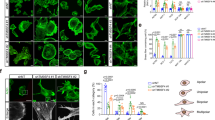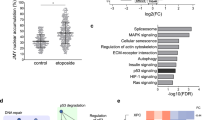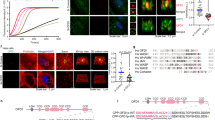Abstract
The Wilms’ tumour suppressor, WT1, is a zinc finger protein with key roles in normal development of the genitourinary system and tumourigenesis. Mutations or deletion of WT1 result in a spectrum of developmental disorders and susceptibility to Wilms’ tumour in children. Ectopic expression of Wt1 associated with oncogenic functions has been observed in a large number of malignancies, including haematological and solid cancers. Although Wt1 is predominantly a nuclear protein in normal tissues, it is mostly cytoplasmic in the majority of Wt1-expressing tumours. Actin was identified in this study as a new WT1 interaction partner both in the nucleus and in the cytoplasm. We confirmed this interaction both in vitro and in vivo and started to explore its functional significance. Perturbation of the actin cytoskeleton moved Wt1 off the polysome fraction in the cytoplasm, cancelled its nucleo-cytoplasmic shuttling and altered Wt1 DNA- and RNA-binding abilities. These data have implications for Wt1 functions in relation to RNA metabolism and response to cytoskeletal alterations in cancer cells. Thus, our findings could shed more light on the functions of both these proteins and possibly pave way for the development of new cancer therapies.
This is a preview of subscription content, access via your institution
Access options
Subscribe to this journal
Receive 50 print issues and online access
$259.00 per year
only $5.18 per issue
Buy this article
- Purchase on Springer Link
- Instant access to full article PDF
Prices may be subject to local taxes which are calculated during checkout




Similar content being viewed by others
References
Bing Z, Pasha TL, Acs G, Zhang PJ . (2008). Cytoplasmic overexpression of WT-1 in gastrointestinal stromal tumor and other soft tissue tumors. Appl Immunohistochem Mol Morphol 16: 316–321.
Caricasole A, Duarte A, Larsson SH, Hastie ND, Little M, Holmes G et al. (1996). RNA binding by the Wilms tumor suppressor zinc finger proteins. Proc Natl Acad Sci USA 93: 7562–7566.
Davies RC, Calvio C, Bratt E, Larsson SH, Lamond AI, Hastie ND . (1998). WT1 interacts with the splicing factor U2AF65 in an isoform-dependent manner and can be incorporated into spliceosomes. Genes Dev 12: 3217–3225.
de Lanerolle P, Johnson T, Hofmann WA . (2005). Actin and myosin I in the nucleus: what next? Nat Struct Mol Biol 12: 742–746. Review.
Discenza MT, Dehbi M, Pelletier J . (1997). Overlapping DNA recognition motifs between Sp1 and a novel trans-acting factor within the wt1 tumour suppressor gene promoter. Nucleic Acids Res 25: 4314–4322.
Gabert J, Beillard E, van der Velden V, Bi W, Grimwade D, Pallisgaard N et al. (2003). Standardization and quality control studies of ‘real-time’ quantitative reverse transcriptase polymerase chain reaction of fusion gene transcripts for residual disease detection in leukemia—A Europe Against Cancer Program. Leukemia 17: 2318–2357.
Gimona M . (2008). The microfilament system in the formation of invasive adhesions. Semin Cancer Biol 18: 23–34.
Hohenstein P, Hastie ND . (2006). The many facets of the Wilms’ tumour gene, WT1. Hum Mol Genet 15 (Spec No 2): R196–R201. Review.
Jansen RP . (1999). RNA-cytoskeletal associations. FASEB J 13: 455–466. Review.
Jomgeow T, Oji Y, Tsuji N, Ikeda Y, Ito K, Tsuda A et al. (2006). Wilms’ tumor gene WT1 17AA(-)/KTS(-) isoform induces morphological changes and promotes cell migration and invasion in vitro. Cancer Sci 97: 259–270.
Ladomery MR, Slight J, Mc Ghee S, Hastie ND . (1999). Presence of WT1, the Wilm's tumor suppressor gene product, in nuclear poly(A)(+) ribonucleoprotein. J Biol Chem 274: 36520–36526.
Ladomery M, Sommerville J, Woolner S, Slight J, Hastie N . (2003). Expression in Xenopus oocytes shows that WT1 binds transcripts in vivo, with a central role for zinc finger one. J Cell Sci 116 (Pt 8): 1539–1549.
Lee SB, Huang K, Palmer R, Truong VB, Herzlinger D, Kolquist KA et al. (1999). The Wilms tumor suppressor WT1 encodes a transcriptional activator of amphiregulin. Cell 98: 663–673.
Louvet E, Percipalle P . (2009). Transcriptional control of gene expression by actin and myosin. Int Rev Cell Mol Biol 272: 107–147.
Nakatsuka S, Oji Y, Horiuchi T, Kanda T, Kitagawa M, Takeuchi T et al. (2006). Immunohistochemical detection of WT1 protein in a variety of cancer cells. Mod Pathol 19: 804–814.
Niksic M, Slight J, Sanford JR, Caceres JF, Hastie ND . (2004). The Wilms’ tumour protein (WT1) shuttles between nucleus and cytoplasm and is present in functional polysomes. Hum Mol Genet 13: 463–471.
Rao J, Li N . (2004). Microfilament actin remodeling as a potential target for cancer drug development. Curr Cancer Drug Targets 4: 345–354.
Sheikh S, Gratzer WB, Pinder JC, Nash GB . (1997). Actin polymerisation regulates integrin-mediated adhesion as well as rigidity of neutrophils. Biochem Biophys Res Commun 238: 910–915.
Spraggon L, Dudnakova T, Slight J, Lustig-Yariv O, Cotterell J, Hastie N et al. (2007). hnRNP-U directly interacts with WT1 and modulates WT1 transcriptional activation. Oncogene 26: 1484–1491.
Tellman G, Geulen O . (2006). LightCycler 480 Real-Time PCR System: innovative solutions for relative quantification. Biochemica 4: 16–18.
Vajjhala P, Macmillan E, Gonda T, Little M . (2003). The Wilms’ tumour suppressor protein, WT1, undergoes CRM1-independent nucleocytoplasmic shuttling. FEBS Lett 554: 143–148.
Viney R, Morrison A, van den Heuvel L, Ni L, Mathieson P, Saleem M et al. (2007). A proteomic investigation of glomerular podocytes from a Denys-Drash Syndrome patient with a mutation in the Wilms tumour suppressor gene WT1. Proteomics 7: 804–815.
Acknowledgements
We thank Drs J Caceres and S Guil for their useful advice and GFP-hnRNP A1 and GFP-SF2 expressing constructs and anti-hnRNP A1 antibody. We also thank Mr Nick Tomczyk from the Chemistry Department at the University of Edinburgh for carrying out MALDI-TOF analysis. This study was funded by a core grant from the MRC and an EU Marie Curie Fellowship to TD.
Author information
Authors and Affiliations
Corresponding author
Rights and permissions
About this article
Cite this article
Dudnakova, T., Spraggon, L., Slight, J. et al. Actin: a novel interaction partner of WT1 influencing its cell dynamic properties. Oncogene 29, 1085–1092 (2010). https://doi.org/10.1038/onc.2009.444
Received:
Revised:
Accepted:
Published:
Issue Date:
DOI: https://doi.org/10.1038/onc.2009.444
Keywords
This article is cited by
-
A new approach for examining the neurovascular structure with phalloidin and calcitonin gene-related peptide in the rat cranial dura mater
Journal of Molecular Histology (2020)
-
Cucurbitacin I inhibits STAT3, but enhances STAT1 signaling in human cancer cells in vitro through disrupting actin filaments
Acta Pharmacologica Sinica (2018)
-
Wt1 in the kidney—a tale in mouse models
Pediatric Nephrology (2014)
-
Targeting NADPH oxidases for the treatment of cancer and inflammation
Cellular and Molecular Life Sciences (2012)



